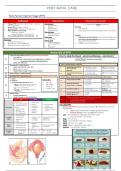Summary
Summary Final year MD notes - post-natal care
A collection suite of final obstetrics and gynaecology MD notes to ace your penultimate and final year exams!
Look no further and save the stress of accessing multiple resources as this PDF collates and summarises information from several resources including but not limited to:
-Talley and O�...
[Show more]
Uploaded on
December 4, 2023
Number of pages
6
Written in
2023/2024
Type
Summary
post natal
care
childbirth
obstetrics
medicine
final
student
year
post partum
breastfeeding
notes
Institution
Macquarie University (MQ
)
Course
Unknown
$8.23
Also available in package deal from $66.43
100% satisfaction guarantee
Immediately available after payment
Both online and in PDF
No strings attached
Also available in package deal (1)
Final year obstetrics and gynaecology notes - ***BUNDLE Deal***
1. Summary - Final year md notes - contraception
2. Summary - Final year md notes - fertility
3. Summary - Final year md notes - gynaecological cancers
4. Summary - Final year md notes - genitourinary medicine
5. Summary - Final year md notes - early pregnancy
6. Summary - Final year md notes - labour and delivery
7. Summary - Final year md notes - gynaecology
8. Summary - Final year md notes - post-natal care
9. Summary - Final year md notes - antenatal care
10. Summary - Final year md notes - reproductive system
Show more
POST-NATAL CARE




